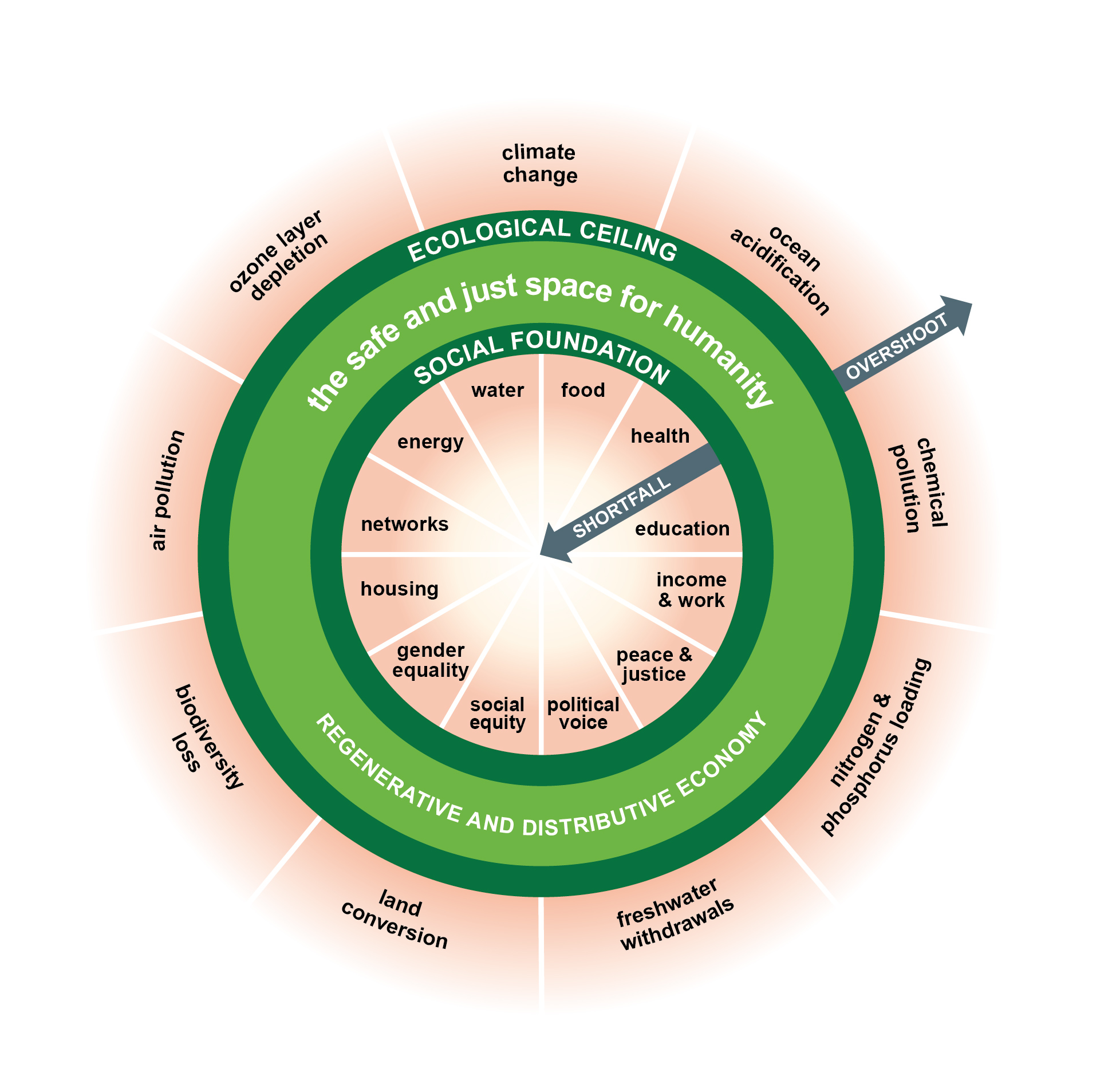Amsterdam has adopted a doughnut economics approach in its Amsterdam Circular 2020-2025 Strategy, so that Amsterdam can be a “thriving and equitable city” that ensures “a good life for everyone within the Earth’s natural boundaries.”1
What is doughnut economics?
The doughnut model was developed by Kate Raworth, author of Doughnut Economics: Seven Ways to Think Like a 21st-Century Economist.
The doughnut model encapsulates that economics should be about “meeting the human rights of every person within the means of our life-giving planet.”2 The doughnut (depicted in Figure 1) reflects that between a social foundation of human wellbeing and ecological ceiling of planetary pressures is the safe and just space for humanity. The inside ring of the doughnut represents the minimum required for every person, including water, food, and energy. The outside ring of the doughnut outlines the ecological limits of the planet, such as climate change, ocean acidification and biodiversity loss.

How can it be applied to a city?
This month, Kate Raworth introduced the Amsterdam City Doughnut, which takes the concept of the doughnut and turns it into a tool for transformation action in the city of Amsterdam. The doughnut model was scaled down to provide Amsterdam with a city portrait that shows where basic needs are not being met and where the planetary boundaries are being overshot. These insights were then used to inform the Amsterdam Circular 2020-2025 Strategy, and the strategy actions were also checked against how it would impact on the doughnut.
For example, Amsterdam set an ambition to care for natural resources together by making “sharing and repairing made easy, accessible and affordable”.1 One of the courses of actions to achieve this is improving the city’s infrastructure for sharing and reuse. Examples of initiatives to achieve this “are ‘libraries’ for products such as clothing and tools and accessible repair cafés.”1 This will have a positive impact socially and ecologically as a whole, but in particular it would support networks, work and income, and social equality.
How can we apply this tool in New Zealand?
Kate Raworth and the Doughnut Economics Action Lab team are preparing resources to enable others to use the doughnut economics tool locally, regionally or nationally.
In the interim, you can test your current policy and objectives against the principles of the doughnut economy with the parties concerned. This will highlight any areas in which action is required. Strategies with concrete and specific courses of action should be developed based on these. These courses of action should then be tested against the doughnut to check if it will positively contribute towards “meeting the human rights of every person within the means of our life-giving planet.”2 It will also require collecting more data (especially in relation to ecology) and developing a monitor to track progress.
Further information of the Amsterdam Circular 2020-2025 Strategy
The Amsterdam Circular 2020-2025 Strategy outlines the following areas requiring action, further details on the courses of action can be found in the strategy document.
Food & organic waste streams
- Create circular food production in (and for) urban areas
- Encourage healthy, sustainable and plant-based food consumption by all inhabitants
- Minimise food waste by retail, hotels and restaurants, and households
- Scale up the separate collection of organic waste from households and businesses for high-quality processing
- Scale up high-quality processing of biomass and food waste streams
- Accelerate the closure of local nutrient cycles from biomass and (waste) water streams.
Consumer goods
- Reduce consumption and avoid overconsumption
- Stimulate high-quality recycling of complex consumer goods
- Aim for shared and long-term use of products
- Increase the number of local craft centres for repair and restoration of products
- Use and design standardised and modular products that are suitable for reuse, repair, and recycling.
Built environment
- Stimulate circular area development with an urban design, an integrated approach and climate-proof construction, with special attention paid to closing cycles
- Use circular criteria in land allocation and tendering of all construction and infrastructural projects and in the public space
- Develop buildings with adaptable functions and systems
- Scaling up circular disassembly and separate collection for the purpose of high-quality applications
- Use renewable and secondary building materials
- Stimulate circular renovation in private and social housing.
1. https://assets.amsterdam.nl/publish/pages/867635/amsterdam-circular-2020-2025_strategy.pdf
2. Kate Raworth, (2017). Doughnut Economics: Seven Ways to Think Like a 21st-Century Economist